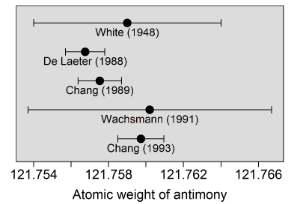Best Measurements of Isotopic Composition
Since 1975, the CIAAW identifies the best mass spectrometric measurements of isotopic composition of the elements from a single terrestrial sample published in the peer-reviewed literature.
These studies are known as 'IUPAC Best Measurements' and they play a significant role in setting the standard atomic weight of an element.
The Best Measurement may be defined as a set of analyses of the isotope-amount ratios of an element in a well-characterized,
representative material with small combined uncertainty. A Best Measurement is not necessarily free of systematic errors, nor is it necessarily calibrated; it is just the best measurement available.
To be considered by the CIAAW for evaluation, reports must be published in peer-reviewed literature, and the results should be given with sufficient detail so that the CIAAW can reconstruct the uncertainty budget in its various components, including sample preparation,
analysis of isotope-amount ratios, and data handling.
The second column ('Type') refers to the type of measurement and this column is still being completed.
Criteria used by the CIAAW to evaluate a Best Measurement include:
The Commission seeks evidence that mass-spectrometer
linearity, mass-spectrometric fractionation of ions of varying masses, memory, baseline, interference between ions,
sample purity and preparation effects, and statistical assessment of data were carried out properly.
Preference is given to measurements that are fully calibrated with synthetic
mixtures of isotopes of the element of interest, covering the isotopic-abundance variations of naturally occurring materials
over the interval of the masses of the isotopes in the material being analyzed.
Preference is given to analyses of chemically stable materials that are distributed
internationally as isotopic reference materials or to isotopically unfractionated representatives of homogeneous terrestrial materials.
© CIAAW 2018 (last updated Dec 2019)

CIAAW
The CIAAW has determined that new, calibrated isotopic-composition measurements could improve the standard atomic-weight values of a number of elements that have relatively large uncertainties. Such elements include gadolinium, palladium, and samarium.


